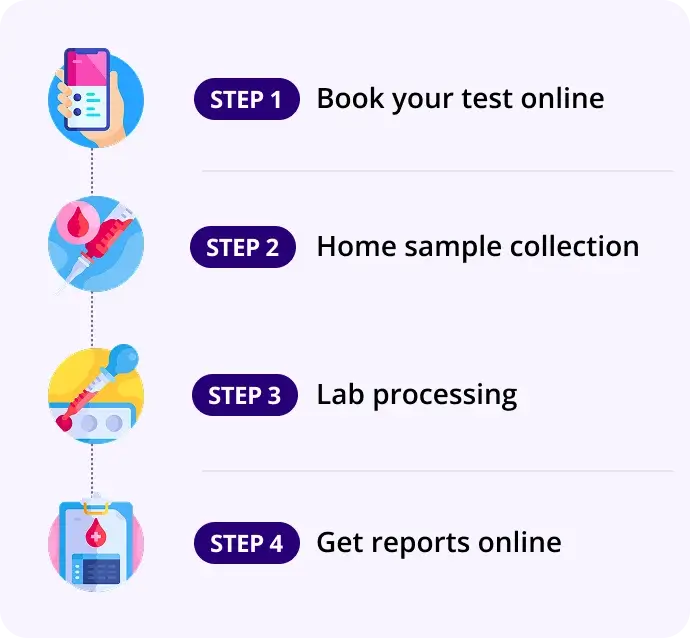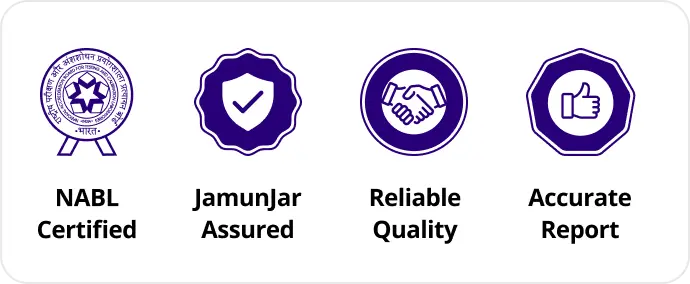Double Marker - First Trimester
Report in 60Hrs
At Home
No Fasting Required
Details
Non-invasive prenatal blood test done during the first trimester of pregnancy to assess the risk of chromosomal abnormalities in the fetus
₹699₹2,200
68% OFF
🧪 What is the Double Marker Test?
The Double Marker Test is a non-invasive prenatal blood test done during the first trimester of pregnancy to assess the risk of chromosomal abnormalities in the fetus, particularly:
- Trisomy 21 (Down syndrome)
- Trisomy 18 (Edward syndrome)
- Trisomy 13 (Patau syndrome)
It measures two biochemical markers in the mother's blood:
- Free Beta-hCG (human chorionic gonadotropin)
- PAPP-A (Pregnancy-Associated Plasma Protein-A)
It is usually combined with a nuchal translucency (NT) scan for higher accuracy.
❓ Why is the Double Marker Test Done?
To:
- Screen for chromosomal disorders early in pregnancy
- Estimate risk level (not provide a diagnosis)
- Identify high-risk pregnancies that may need further diagnostic testing (like NIPT, CVS, or amniocentesis)
- Provide peace of mind for low-risk pregnancies
🗓️ When is it Done?
- Ideally between 9 to 13 weeks of gestation
- Often part of first trimester combined screening (with NT scan)
📊 Normal Ranges & Interpretation
Biomarkers:
Marker | Normal Trend |
|---|---|
Free Beta-hCG | Should be within normal gestational range; very high can be linked with Down syndrome |
PAPP-A | Lower levels may suggest risk of chromosomal abnormalities |
Risk Categorization (based on software-calculated values):
Risk Score | Interpretation |
|---|---|
Low Risk | < 1 in 250 (generally reassuring) |
High Risk | ≥ 1 in 250 (requires follow-up testing) |
🔍 The final risk is calculated using:
- Mother's age
- Gestational age
- Blood levels of hCG and PAPP-A
- NT scan result (if available)
🧬 Interpretation of Results
Result | Possible Implication |
|---|---|
⬆️ hCG, ⬇️ PAPP-A | Suggestive of Down syndrome risk |
⬇️ Both hCG & PAPP-A | May indicate Trisomy 18 or 13 |
Normal values | Generally indicates low risk, but not a guarantee of a healthy fetus |
🧠 Associated Organs and Conditions
Area | Impact |
|---|---|
Fetus (genetic material) | Chromosomal aneuploidies (Trisomies) |
Placenta | PAPP-A is produced by the placenta; abnormal levels may also hint at placental insufficiency |
Uterus (pregnancy outcome) | High-risk scores may correlate with miscarriage or preterm labor risk (less commonly) |
🔄 Related / Follow-Up Tests
- NT Scan (Ultrasound) – Measures fluid at back of fetal neck
- NIPT (Non-Invasive Prenatal Testing) – High-accuracy screening via fetal DNA
- Triple Marker / Quadruple Marker – Done in the second trimester
- Chorionic Villus Sampling (CVS) – Invasive, for definitive diagnosis
- Amniocentesis – Invasive genetic diagnostic test (done after 15 weeks)
📝 Summary
Parameter | Summary |
|---|---|
What | First-trimester maternal blood test to assess risk of chromosomal abnormalities |
Why | Early screening for Down syndrome, Trisomy 18/13 |
When | Between 9–13 weeks of pregnancy |
Measured Markers | Free Beta-hCG, PAPP-A |
Normal Result | Low risk for aneuploidy (e.g., <1 in 250) |
Positive/High Risk | Suggests elevated chance of fetal chromosomal disorder — requires confirmation |
Follow-up | NT scan, NIPT, CVS, Amniocentesis |
How our test process works!

